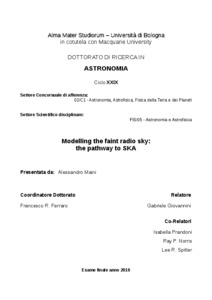Maini, Alessandro
(2016)
Modelling the Faint Radio Sky: The Pathway to SKA, [Dissertation thesis], Alma Mater Studiorum Università di Bologna.
Dottorato di ricerca in
Astronomia, 29 Ciclo. DOI 10.6092/unibo/amsdottorato/7763.
Documenti full-text disponibili:
![[img]](http://amsdottorato.unibo.it/7763/1.hassmallThumbnailVersion/maini_alessandro_tesi.pdf)  Anteprima |
|
Documento PDF (English)
- Richiede un lettore di PDF come Xpdf o Adobe Acrobat Reader
Disponibile con Licenza: Salvo eventuali più ampie autorizzazioni dell'autore, la tesi può essere liberamente consultata e può essere effettuato il salvataggio e la stampa di una copia per fini strettamente personali di studio, di ricerca e di insegnamento, con espresso divieto di qualunque utilizzo direttamente o indirettamente commerciale. Ogni altro diritto sul materiale è riservato.
Download (30MB)
| Anteprima
|
Abstract
In the last decade our understanding of the faint radio sky has undergone a significant change. Our perception of weak radio sources has been deeply changed due to the discovery that the so-called radio-quiet active galactic nuclei are not, in fact, radio silent, but simply faint as they finally started to be detected. Moreover, a new, unexpected class of radio-loud active galactic nuclei has been recently discovered, the so-called infrared-faint radio sources. This class of rare objects discovered in deep radio surveys, is emerging as a potentially promising class of sources to pre-select high-redshift powerful radio-loud active galactic nuclei.
In this Thesis, I present my contribution to the ongoing efforts to understand the nature of both these types of active galactic nuclei.
The future, planned sub-mJy radio surveys (the ones expected to be delivered by the new facilities like ASKAP and SKA) will sample active galactic nuclei in the million, and the above mentioned classes will constitute a relevant fraction of the future radio catalogues. Developing methods to recognise them, and to correctly address their nature, is fundamental to fully exploiting these surveys.
Abstract
In the last decade our understanding of the faint radio sky has undergone a significant change. Our perception of weak radio sources has been deeply changed due to the discovery that the so-called radio-quiet active galactic nuclei are not, in fact, radio silent, but simply faint as they finally started to be detected. Moreover, a new, unexpected class of radio-loud active galactic nuclei has been recently discovered, the so-called infrared-faint radio sources. This class of rare objects discovered in deep radio surveys, is emerging as a potentially promising class of sources to pre-select high-redshift powerful radio-loud active galactic nuclei.
In this Thesis, I present my contribution to the ongoing efforts to understand the nature of both these types of active galactic nuclei.
The future, planned sub-mJy radio surveys (the ones expected to be delivered by the new facilities like ASKAP and SKA) will sample active galactic nuclei in the million, and the above mentioned classes will constitute a relevant fraction of the future radio catalogues. Developing methods to recognise them, and to correctly address their nature, is fundamental to fully exploiting these surveys.
Tipologia del documento
Tesi di dottorato
Autore
Maini, Alessandro
Supervisore
Co-supervisore
Dottorato di ricerca
Ciclo
29
Coordinatore
Settore disciplinare
Settore concorsuale
Parole chiave
Radio-loud active galactic nuclei
Radio-quiet active galactic nuclei
High-redshift galaxies
Infrared-faint radio sources
Infrared galaxies
URN:NBN
DOI
10.6092/unibo/amsdottorato/7763
Data di discussione
25 Novembre 2016
URI
Altri metadati
Tipologia del documento
Tesi di dottorato
Autore
Maini, Alessandro
Supervisore
Co-supervisore
Dottorato di ricerca
Ciclo
29
Coordinatore
Settore disciplinare
Settore concorsuale
Parole chiave
Radio-loud active galactic nuclei
Radio-quiet active galactic nuclei
High-redshift galaxies
Infrared-faint radio sources
Infrared galaxies
URN:NBN
DOI
10.6092/unibo/amsdottorato/7763
Data di discussione
25 Novembre 2016
URI
Statistica sui download
Gestione del documento:


 Login
Login
